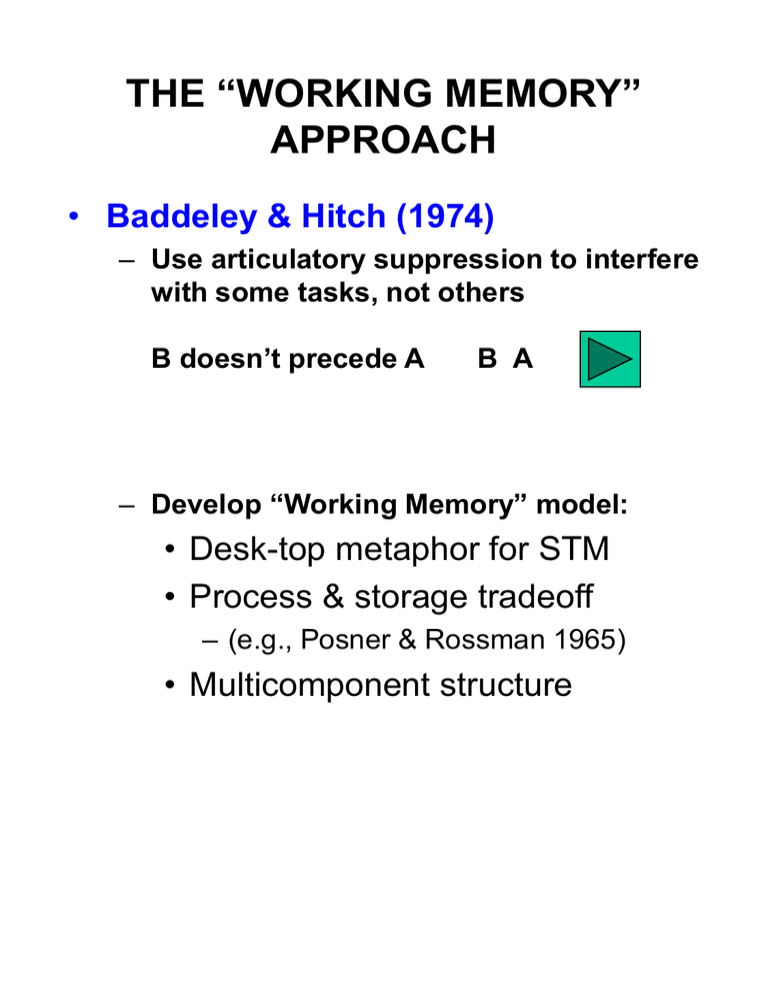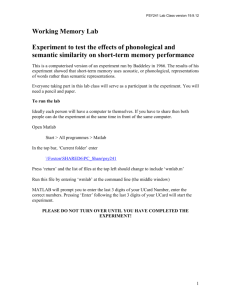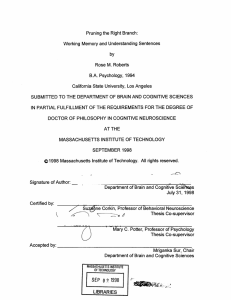THE “WORKING MEMORY” APPROACH Baddeley & Hitch (1974) • Desk-top metaphor for STM
advertisement

THE “WORKING MEMORY” APPROACH • Baddeley & Hitch (1974) – Use articulatory suppression to interfere with some tasks, not others B doesn’t precede A B A – Develop “Working Memory” model: • Desk-top metaphor for STM • Process & storage tradeoff – (e.g., Posner & Rossman 1965) • Multicomponent structure COMPONENTS OF WORKING MEMORY (Baddeley, 1990) (Random letter generation) Central executive (attentional control) Phonological store Visual-spatial sketchpad (Repetitive articulation) (Repetitive keying) Concurrent Articulation and the Phonological Store (Peterson & Johnson, 1971) No Concurrent Task 1 Visual Auditory Percent Correct 0.9 0.8 0.7 0.6 0.5 0.4 0.3 0.2 0.1 0 Dissimilar Similar Type of List Concurrent Articulation 1 Percent Correct 0.9 Visual Auditory 0.8 0.7 0.6 0.5 0.4 0.3 0.2 0.1 0 Dissimilar Type of List Similar WORKING MEMORY AND CHESS (Robbins, 1996) Primary task: recall of chess piece positions Mean correct recall Secondary tasks: N None P articulate “the, the..” V execute 4x4 key pattern CE generate random letters N P V CE DISSOCIATING THE SKETCHPAD FROM THE LOOP • Instances of selective interference (e.g., Brooks, 1968) • Imaging evidence (Jonides, 1995) – The n-back task 2-back: M P F P verbal: match letter identity + + Spatial: match location of dot in array Dorsolateral Prefrontal lights up: • Left side for verbal task • Right side for spatial task Prefrontal Activity Varies with Memory Demand Rypma, et al. (2002) 1, 3 or 6 letters in memory set • Low memory-demand activity limited to Ventrolateral Prefrontal Cortex • High memory-demand also activates Dorsolateral Prefrontal cortex • Differences are largest for highperformance subjects WM ACTIVITY and LTM ENCODING • Greater fMRI activity during WM trial correlated with: – better WM performance (Pessoa, et al. 2002 – Memory load for good performers (Rypma, et a., 2002) – Better subsequent LTM (Brewer, et al. 1988) • Integrative WM tasks (e.g., item x location) correlated with: – Greater “remember” judgments – Specific areas of “coupling” of PFC and other cortical areas – Greater memory-contingent PFC effect for associative than item memory (Howland, 2005) – Baddeley’s “Episodic Buffer”? WORKING MEMORY SPAN AND COGNITIVE PERFORMANCE • Daneman & Carpenter (1980) – Reading Span, not digit span, correlates with reading comprehension The witness examined by the attorney… The evidence examined by the attorney… • Engle et al. (1995) – Develop other “spans” (Operation Span) – Argue it’s not “capacity” but skill at controlling tasks and codes, inhibition, etc. – James’ “span of consciousness?” Some Baddeley & Hitch 1974 trials Repeat 2,5,8,3 rapidly A doesn’t follow B A B D precedes G G D X follows Y X Y N doesn’t precede R R N Posner & Rossman 65 Demonstration • Set 1: write down last two digits, and add one ARAP, e.g. 91/92/93 – 26457381 – 75248619 – 13245768 • Set 2: write down last two digits, and subtract 3 ARAP e.g. 91/88/85 – 54723169 – 71289435 – 65382147 should be greater errors in Set 2, as difficulty of “work” in WM makes storage/refreshing of PL harder N-back demo • 0-back series (target is “S” – EDTWSVDDSGHRS • 1-BACK (REPETITION) – NKQQFTLCCWTSSQ • 2-BACK (LAG OF 2) – QXFXWTTWTJLJN




